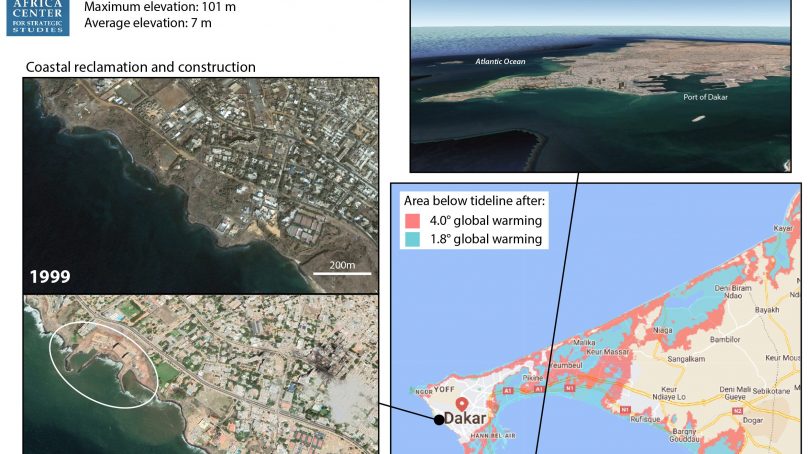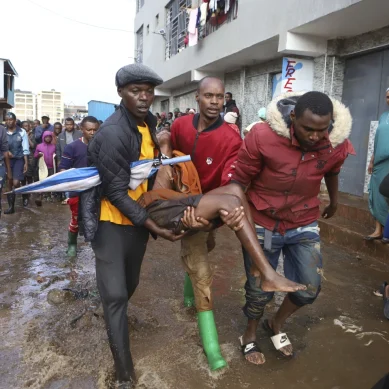
Rising ocean levels threaten dozens of Africa’s rapidly expanding coastal metropolises, resulting in shrinking land area, coastal flooding, more powerful storm surges and the need for better mitigation.
African coastlines have experienced a steady rise in sea levels for four decades. At the current pace, sea levels are projected to rise by 0.3 meters by 2030, affecting 117 million Africans. If global warming is contained to 2˚C above 1990 levels, sea level rise may be limited to 0.4 meters.
However, a 4˚ C level of global warming would lead to a 1-metre rise in sea levels by the end of the century.
The global rise in sea levels is an outcome of the build-up of greenhouse gas emissions that has resulted in a 0.63˚C-increase in median ocean temperatures over the past century. Rising ocean and atmospheric temperatures have resulted in the melting of the polar ice caps and thermal expansion (which causes the volume of water to increase), causing the increase in ocean levels.
Rising sea levels are triggering coastal flooding and erosion as well as the loss of the coastal habitats that provide natural shoreline protection from storm surges. The loss of these habitats increases the number of people at risk.
The rise in sea levels is occurring as the population of Africa’s coastal cities is skyrocketing.
The rise in sea levels is occurring as the population of Africa’s coastal cities is skyrocketing. Between 2020 and 2030, Africa’s 7 largest coastal cities – Lagos, Luanda, Dar es Salaam, Alexandria, Abidjan, Cape Town, and Casablanca – are projected to grow by 40 per cent (48 million people to 69 million) compared with the continent’s overall anticipated increase of 27 per cent (1.34 billion to 1.69 billion).
Smaller coastal cities may expand even faster: Port Harcourt in Nigeria, for example, is expected to grow 53 per cent over this decade. Globally, Africa’s coastal regions are anticipated to experience the highest rates of population growth and urbanisation in the world.
This demographic pressure is being driven by the economic significance of Africa’s coastal cities. Africa’s blue economy – comprising ports, fisheries, tourism and other coastal economic activity – is conservatively projected to grow from $296 billion in 2018 to $405 billion by 2030. Coastal megacities like Lagos and Dar es Salaam power national economies. The GDP of Lagos, for example, is greater than 46 of Africa’s 54 countries.
Africa’s coastal cities serve as the critical gateways to the continent’s vast interior. Disruptions to port cities caused by rising sea levels can have cascading effects on the logistical networks and economies that they support. An estimated 90 per cent of Africa’s import and export trade comes through coastal ports.
With a rapidly growing share of Africans living in coastal regions, rising sea levels represent a highly tangible and disruptive impact of global warming on a continent already experiencing rapid population growth and land pressures. In addition to population displacements, rising sea levels will place enormous strain on infrastructure, agriculture, and water access for African citizens, heightening the risk of instability.
Coastal cities not only face the direct threat from rising sea water and storm surges. They also face the unseen threat from groundwater rising, turning urban areas into wetlands. From the erosion of roads and building foundations to backflowing sewers, leeching septic systems, inundated cesspools turned microbe breeding ponds, cities will face myriad infrastructure and public health crises. In Lagos, 50 per cent of hospitalized patients suffer from water-borne diseases.
Rising sea levels also threaten coastal residents by contaminating aquifers. Coastal aquifers provide water for drinking and irrigating crops. Coastal aquifers are vulnerable to saltwater intrusion, even from minor rises in sea levels, particularly in the coastal areas of North Africa where groundwater is overexploited to support the growing population and agriculture.
Rising oceans are also behind the increasing incidences of “100-year floods” (having a one per cent chance of occurring in any given year). Historically rare, extreme sea level events (the combination of mean sea level, tides and wave surges) are occurring increasingly frequently, especially in tropical regions.
Across large African river basins, the frequency of 100-year flood events is projected to increase to 1 in 40 years at 1.5°C and 2°C global warming, and 1 in 21 years at 4°C warming. Under the business-as-usual model, for some parts of coastal West and East Africa, these extreme outcomes could become annual events.
Since the 1980s, marine heatwaves have become more frequent, more intense, and longer, exposing species and ecosystems to environmental conditions beyond their tolerance limits.
The number of African marine heatwaves doubled in the North African Mediterranean Sea and along the Somalian and southern African coastlines from 1982-2016. If global warming continues unabated, the strength and duration of these events are expected to overwhelm the ability of many marine organisms to adapt.
This may result in the destruction of marine ecosystems and the extinction of numerous marine species. Impacts include repeated mass coral bleaching events in East Africa and the poleward migration of marine life from their original habitats, leading to lost livelihoods for African fishers. This would result in a 30-per cent contraction of Africa’s $25 billion annual marine fisheries sector by 2050 with West Africa being particularly hard hit.
By 2030, an estimated 108-116 million people in Africa will live in low elevation coastal zones – defined as areas 10 metres or less above sea level, a figure projected to double by 2060.
In the near term, North and West Africa will be most directly affected, comprising 85 per cent of the projected 100 million population affected on the continent, although every region is threatened/
Egypt and Nigeria, both with high density metropolises near the coast, are anticipated to face the greatest population disruptions. In Egypt, a 0.5- to 1-meter sea level rise will result in the coastline shifting inland by several kilometres, submerging a large area of the Nile Delta.
Africa’s vulnerability is exacerbated by rapidly increased coastal development. Unfortunately, some of the more densely packed cities – such as Lagos, Dakar and Alexandria – are victims of poor coastal planning. They are not alone. About 56 per cent of the coastline in Benin, Côte d’Ivoire, Senegal, and Togo is exposed to an average erosion of two metres per year. The World Bank estimates this erosion, flooding and pollution inflict $3.8 billion in damage for these countries annually. Many coastal residents will be forced to relocate.











